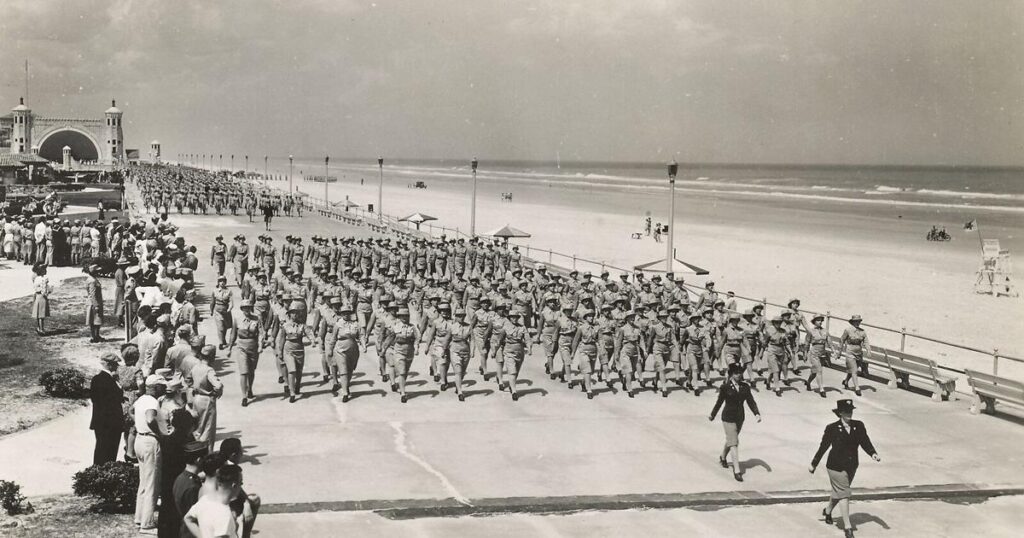Two important chapters in Daytona Beach history — the World’s Most Famous Beach and an invasion of the Women’s Army Corps during World War II – will be highlighted in an exhibit opening Oct. 1 at the Halifax Historical Society and Museum.
“We are very excited about these exhibits, for all the tourists and residents of this area,” stated Richard Sala, HHS president, in a news release.
An interactive display on the WACs is expected to draw keen interest and visitors will learn about the attraction of the beach and its spot in surfing history. The exhibit will be visited by the Florida Association of Museums membership in conjunction with a state meeting here.
Early in 1941, Congresswoman Edith Nourse Rogers introduced a bill to establish an Army women’s corps, separate from the nursing unit. The attack on Pearl Harbor on Dec. 7, 1941, galvanized those efforts.
The training site in Daytona Beach for the Women’s Army Corps, formerly the Women’s Army Auxiliary Corps, was selected as one of three in the nation with the help of some close friends, First Lady Eleanor Roosevelt and college founder Mary McLeod Bethune. It was seen as a way to boost the ailing tourist industry, using hotel rooms as housing.
Women volunteers who would fulfill an official role in the war in the coming months were recruited and brought to Daytona Beach, where government housed them in hotels until a cantonment was built in what was then known as the Welch Area. Some lived in tents at Bethune Beach. Due to a supply mix-up, shipments of woolens were sent to Daytona Beach while cotton clothing went to the Des Moines facility.
At one time, there were 14,000 of the 150,000 recruits nationwide in Daytona Beach. They were sworn in at ceremonies at the Beachside Boardwalk against a magnificent backdrop of the World’s Most Famous Beach. Word came down on Dec. 13, 1943, that the military training center would close.
The cantonment became the Welch Convalescent Center to treat wounded servicemen, until 1946 when it was closed by the Army.
Although it was the duty of WAC members to keep traffic off the beach at night during the war, the 23 miles of hard-packed sand had served as the city’s welcome mat since the late 1800s.
Early photos of the beach show both motorized cars and horse-driven vehicles transporting visitors to the beach. Men were dressed in suits, complete with hats, and ladies sauntered at the water’s edge, their full-length skirts dragging in the surf.
Daytona Beach is credited with being the first Florida city to invite tourists. First, it was a winter mecca, filled with visitors escaping the harsh winter climates. Ultimately, a year-round set of visitors jammed the sands.
The city is also known as being known for the home of a unique form of recreation – surfing. Daytona Beach became Florida’s Surf City as young men swam out from shore to balance themselves on long, narrow boards with the goal of riding the waves into shore..
Surfer Tom Blake came here in 1933 and soon introduced his hollow surfboards. The Whitman Brothers, who started out in Miami Beach, drove into Daytona Beach with their Hawaiian-style boards. They joined a growing number of young men who became surfing pioneers. Nearly 90 surfboards were built in shop classes at Seabreeze and Mainland High Schools.
Daytona Beach’s reputation for speed grew over the years with the advent of motorized cars, who raced along the white sands in time trials, later competing on the beaches in Volusia County.
Memorabilia from the WAC’s and mementoes of Daytona Beach’s famous oceanfront playground will be featured in a series of displays within the exhibits starting Oct. 1.
HHS President Sala said the WAC display will be interactive for FAM, featuring live models in uniform and a special surprise for those who follow the footsteps as a new recruit in the Army unit.
The museum, at 252 S. Beach St., Daytona Beach, is open from 10 a.m. to 4 p.m. Tuesday to Saturday. Admission is $10. Children 12 and under are free. For more information, call (386) 255-6976.
